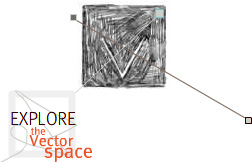Digital Dynamics Across Cultures
Design by Alessandro Ceglia
Producer's Statement
The concept for Digital Dynamics Across Cultures is a virtual space for non-Aboriginal people to engage with Aboriginal cultural protocols. The vision is a dynamic and evolutionary site grounded in the necessary viewing restrictions required by Aboriginal systems of accountability. The interface to the content is experiential, utilizing the non-linear and generative aspects of database-driven multimedia.
The majority of the video and photographic content on the site is from Dr. Kimberly Christen's 10-year collaboration with members of the Warumungu Aboriginal community in Tennant Creek, Australia. The goal of Kim's photographic and video gathering was to document and preserve stories and historical information for later translation and transcription, not to visualize a complex protocol system for public viewing. This posed the challenge of how to repurpose this existing content while preserving the integrity of the information.
The primary content and production challenges of the project were:
- Distill hundreds of hours of video footage and nearly 1000 photographs into focused "content groups" which address specific cultural protocols
- Establish a comprehensive and extensible information structure that allows for content management and presentation consistent with Aboriginal cultural protocols
- Create a compelling and usable interface that is familiar to both Aboriginal and non-Aboriginal audiences
TOO MUCH CONTENT
Our first level of selection and grouping of content was by location, as "country" or place is central to Warumungu culture. Presenting the content in this way highlights the differences and similarities of each of the sites.
Our initial concept for the second level of content grouping was using historical contexts familiar to both the Aboriginal community and researchers working in Tennant Creek. The initial categories (mining, settlers, missions, Aboriginal, other Aboriginal) made it easy to select appropriate content. These were mapped to the interface as "tracks" connecting each place and shown as a group of "nodes". However, as we started to work with these content groups within the interface, it became clear that this approach was muddying the intended purpose of the site: to make Aboriginal cultural protocols evident.
The primary purpose of the site is to demonstrate how Aboriginal cultural protocols function in relation to knowledge production, reproduction and reuse, not necessarily to educate people about other aspects of Aboriginal culture or the history of the region. We decided that each group of content should call attention to a specific cultural protocol and direct learning toward that goal. This resulted in much less explanatory text and more concise content groups, relying on visual and audio to set tone for the specific protocol, rather than explain another level of information.
INFORMATION STRUCTURE
I will leave the detailed discussion of the workings of the backend to our collaborator Alessandro Ceglia. However, I would like to comment on the intention of its design and an unfortunate test it faced during production.
Early in the design phase we decided the site would not attempt to fully emulate the "rules" of Aboriginal cultural protocols through role playing where a user could take on various "roles," then experience each based on complex algorithms modeling protocols. However, elements of this modeling were required for the backend system to allow Aboriginal content owners to manage display of information. Aboriginal protocols dealing with the death of a community member require that when a person passes away their image is not displayed publicly for a specified period of time. It was critical that the system allowed for this functionality.
Shortly before public launch of the site, an elder member of the community passed away. We consulted with the family of the deceased, who requested that the images of that person be taken down from the site for a period of three months. The content management system allowed that change to occur instantly site-wide, while maintaining the original content for when the family chooses to allow it to be shown again publicly.
INTERFACE
"Place" was chosen as the key paradigm for the interface design and gave a common ground to orient both Aboriginal and non-Aboriginal users.
Historical tracks, which over the course of the design process had been relegated to a sorting criteria on the backend system, resurfaced on the interface as a way to show progress through the site. These tracks are shown alongside traditional Aboriginal tracks, placing emphases on the new tracks created in this virtual space.
We now had a solidly maintainable information system and grounded interface of place and tracks. What was missing was the most crucial aspect of the interface, the need to disrupt expectations for both Aboriginal and non-Aboriginal audiences. The intended effect is to momentarily jar the user, calling attention to the fact this is neither a cultural learning site nor a space for open sharing of content. Alessandro's use of unconventional navigation elements, analog masking techniques, and design of the protocol interfaces accomplishes this goal.
The "rough", un-staged nature of much of the content further acts to disrupt expectations. The linear visual narrative is disrupted not just by navigation and protocol dialogs, but also the contrasting images and style. Footage of traditionally painted, bare-breasted women doing a ceremonial dance is juxtaposed with an elderly woman wearing a "Deuce Bigalow" shirt, then an image partially obscured by a piece of masking tape, followed by audio explaining a protocol in unfamiliar Aboriginal English.
The interface allows for these cinema-like edit points to occur within an entirely dynamic system ”" one that is grounded in the protocols it aims to reveal to users in new and hopefully enlightening ways.



